
|
<<<< |

|
>>>> |

|

TRAINS ON U. S. STAMPS
and POSTAL STATIONERY
page 5b
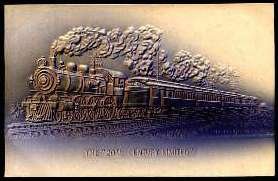
Embossed postcard with train image - 20th Century Limited |
13¢ TRAIN in NEBRASKA STATE SEAL, STATE FLAGS ISSUE
|
|||||

Sc. 1669 - issued 2/23/76 |
There's a train in there somewhere, because according to the Nebraska State Seal page
Nebraska gained statehood as the 37th state in 1867, and the state's first legislature established Nebraska's official seal in the same year. The themes of transportation, industry, settlement, and agriculture are depicted on Nebraska's seal. A railroad train steams across the background, with mountains in the distance. A steamboat plies the waters of the Missouri River. A simple cabin and sheaves of harvested wheat portray the importance of settlers and agriculture. A blacksmith works at his anvil in the foreground. At the top of the seal a banner holds the motto "Equality Before the Law", and around the outside of the seal are the words "Great Seal of the State of Nebraska, March 1st, 1867".
Below are THREE other depictions of the seal - all with a very recognizable train, but no two quite the same, and all differing from the one on the stamp.
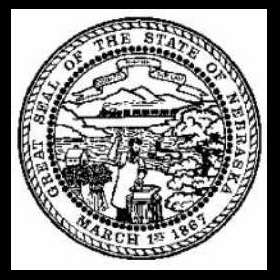
|
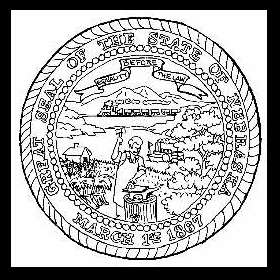
|
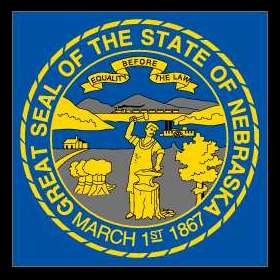
|
Each of these copies of the "Nebraska State Seal" came from what seemed a reliable source, and I must conclude that the Nebraska State Seal (perhaps every State Seal?) has no rigid physical definition - it is the text description in the State's Constitution, as quoted above, and subject to the interpretation of the artist who executes it as an image of some sort.
Given that it was designed in 1867, the fact that this seal includes a train makes perfect sense. Indeed, it's surprising more state seals of the era do not include a train, considering the extent to which the railroads helped settle the area west of the Mississippi.
The growth of railroads encouraged westward expansion more than any other single development. Railroads made it easier for settlers to move west, and railroad corporations vigorously promoted settlement in order to sell the land given them by the government. Railroads also helped industry develop in the West. Many new industries?mining and lumbering, for instance?relied on railroads to carry in equipment and materials that could never have been brought in otherwise. Western companies used the railroads to export the rich resources they found there. The railroads also made it easier to transport troops and war materials, and thereby accelerated the end of Native American independence.
(from http://encarta.msn.com/encyclopedia_761589809_2/Westward_Movement.html, which no longer exists)
As for what sort of locomotive is pulling that train, I think it's safe to say it's an "American" 4-4-0, simply because that's the only style of engine that would have been used in that area at that time. But the definition of the Seal does not stipulate anything specific, so I suppose it could be whatever a particular artist chose to make it!
First Day covers. Because this stamp was part of a sheet of fifty stamps, one per state, one generally has to buy a full set of fifty covers to get even one of them. Just by accident, I do own a set, but the cachet on the cover for this stamp shows nothing but corn, cattle, and wheat, so I won't bother to reproduce it here.
By the way, Nebraska was the last of the continental states to adopt a State Flag, on April 2, 1925. Kansas and Washington preceded it that same year, so it was not alone in delaying the matter so long.
Do you collect Flags On Stamps? Check out this website at: Flags on Stamps
13¢ BICENTENNIAL ENVELOPE
|
||||||
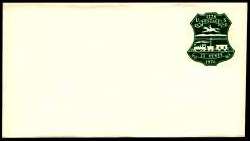
Sc. U582 - issued 10/15/76 |

Sc. U582a - issued 10/15/76 |
By 1976 the USPS had joined the modern consumer age and exercised no restraint whatever in exploiting the Bicentennial - this envelope was just one of thirty separate commemorative issues, with one hundred twenty-two different stamps, issued from 1971 through 1983, as part of the USPS American Bicentennial series. They accounted for six of the eighteen issues of 1976, and seventy-nine of the ninety-one stamps. Granted, fifty of the stamps were the single-pane state flags issue of 1976, and another twenty were on the four souvenir sheets issued at Interphil, the International Philatelic Exhibition held in Philadelphia, May 29-June 6, but even excluding those we have twenty- eight issues, and fifty-one stamps. I won't try to count the definitives with a Bicentennial theme, since one could argue they were necessary for other reasons.
The design of this indicium is obviously copied from the envelope issued in 1876, with the "1876" changed to "1976" and the denomination changed from "THREE" to "13". One of the FDC's I have for this issue describes it as commemorating "The Bicentennial of the United States and the Centennial of the first commemorative envelope." The quality of the embossing is cruder, so the letters "USM" on the side of the mail car, and other details of the earlier design, are not visible, but we still have the post rider and early mail train.
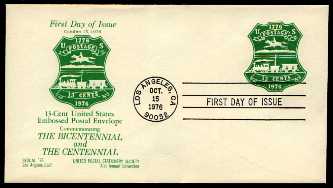
Sc. U582 First Day Cover |
Above is the "official" USPS First Day Cover for this envelope, and below is the text from the USPS First Day of Issue Ceremony, held at Sescal '76, in Los Angeles on October 15, 1976:
|
This 13-cent embossed envelope is a replica of an envelope issued in 1876 at the Centennial Exposition in Philadelphia to commemorate the centenary of the United States. Two embossed envelopes of different sizes and colors were issued then, a green 3-cent stamp on a size 3 envelope and a red 3-cent stamp on a size 4-1/2 envelope. The 1976 envelope reproduces the green stamp which, to collectors of postal stationery, is known as the "Philadelphia Die" and is recognized as the world's first commemorative issue. The design contrasted old and new methods of transporting mail at that time, showing a train and a Pony Express rider. "1776" appeared at the top of the design and "1876" at the bottom. "1776" also appears at the top of the new stamp with "1976" at the bottom. The 13-cent denomination reflects the current first-class mail rate. The dates "1776-1976" emphasize the issuance of the envelope during the 200th anniversary of our country. |
WRONG! Presuming Sloan's information (see page 1a of this exhibit) about Scott U220 was correct, the die reproduced on this envelope is NOT the "Philadelphia", but the "Hartford", since it has just a single line under POSTAGE. Moreover, it is that line (single vs. double), not the color, that distinguishes the dies. Indeed, envelopes exist in both colors for both dies, though the red double-line cover is quite rare.
US TRAINS
|
Send feedback to the webmaster: CLICK HERE
Revised -- 11/30/2004
